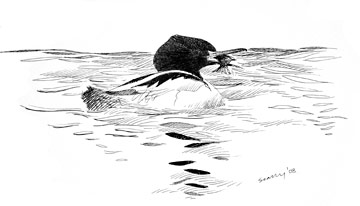
Goosander © Ray Scally
This is by far the most widespread and numerous sawbill wintering in the county, being found in this Atlas in 102 tetrads, compared to 20 for Red-breasted Merganser and 12 for Smew. The female and immature ‘red-heads’ usually considerably outnumber the distinctive adult males. Goosanders are almost all found inland, especially in the south and east of Cheshire, as was the case one hundred (Coward 1910) and fifty (Bell 1962) years ago. Records from Hilbre, and sometimes other Dee sites, have been almost annual, especially in migration periods, and Hilbre had one or two on single dates in three of the four winters 2000/ 01 to 2003/ 04, but none during this Atlas. The map shows that Inner Marsh Farm (SJ37B) and Frodsham Marsh (SJ47Z) are the nearest that Goosanders got to the estuaries during the three years of this winter survey. The origins of those wintering in Cheshire are unknown, but the birds are likely to comprise some from northern Britain and some from continental Europe and Fennoscandia (Migration Atlas). After completing their moult, British Goosanders return from Norway late in the year, few birds being seen before November.
The largest gatherings of Goosander during this Atlas period were on waters not normally featuring at the top of the lists for wildfowl flocks: 59 birds on Oulton Park Lake (SJ56X), 52 at the Chelford SQs (SJ87A/ B/ G), 35 roosting at Bosley Reservoir (SJ96H/ I), 30 on Radnor Mere (SJ87M/ N), a maximum of 23 on the Dee floods near Worthenbury (SJ44I), and 20 on Chapel Mere (SJ55F/ K). More than half of the Atlas records were of just one or two birds.
In contrast to the breeding season, when three-quarters of habitat codes were G7 (river), with 20% on small waterbodies and just one bird on a mere (Rostherne), in winter two-thirds of the birds were using standing water, mostly meres and reservoirs, with the rest on rivers, streams and small canals. They feed almost exclusively on coarse fish, mainly small specimens up to 7.5 cm long.
Some Cheshire waters have been particularly favoured by Goosanders. Bell (1962) wrote that they were liable to visit any of the meres between November and March but they seldom stayed except at Doddington Pool, where they were usually present throughout the winter so long as the water remained open. The maximum count there was 76 in January 1958, although 30 was more normal. He suggested that their predilection for Doddington would provide an interesting subject for research by a hydrobiologist (Bell 1967): forty years on, still little is known about the species’ winter ecology. The annual county bird reports show that a count of around 100 at Doddington in January 1969 was probably the largest flock ever seen in Cheshire. During the 1970s this was still their preferred site when quiet, but was suffering increasing disturbance. From about 1980 onwards the Cholmondeley meres took over as Goosanders’ favoured spot, although numbers were low during much of the 1980s. Goosanders often use different waters at night from their daytime haunts (Brown & Grice 2005) and in 1990 a night-time roost was discovered at Lamaload Reservoir, later found to move between there and the upland reservoirs at Bosley and Trentabank. The normal annual maximum count was 50 or 60 birds, reducing to 30 or 40 from the year 2000 onwards. There have been suggestions that those on the south Cheshire meres and the eastern hill reservoirs are in fact the same birds, making circadian movements. It would be a worthwhile, if challenging, task to test this hypothesis, perhaps using radio-tracked birds, coordinated counts and a team of observers on their flight-lines.
Sponsored by Phil Oddy

